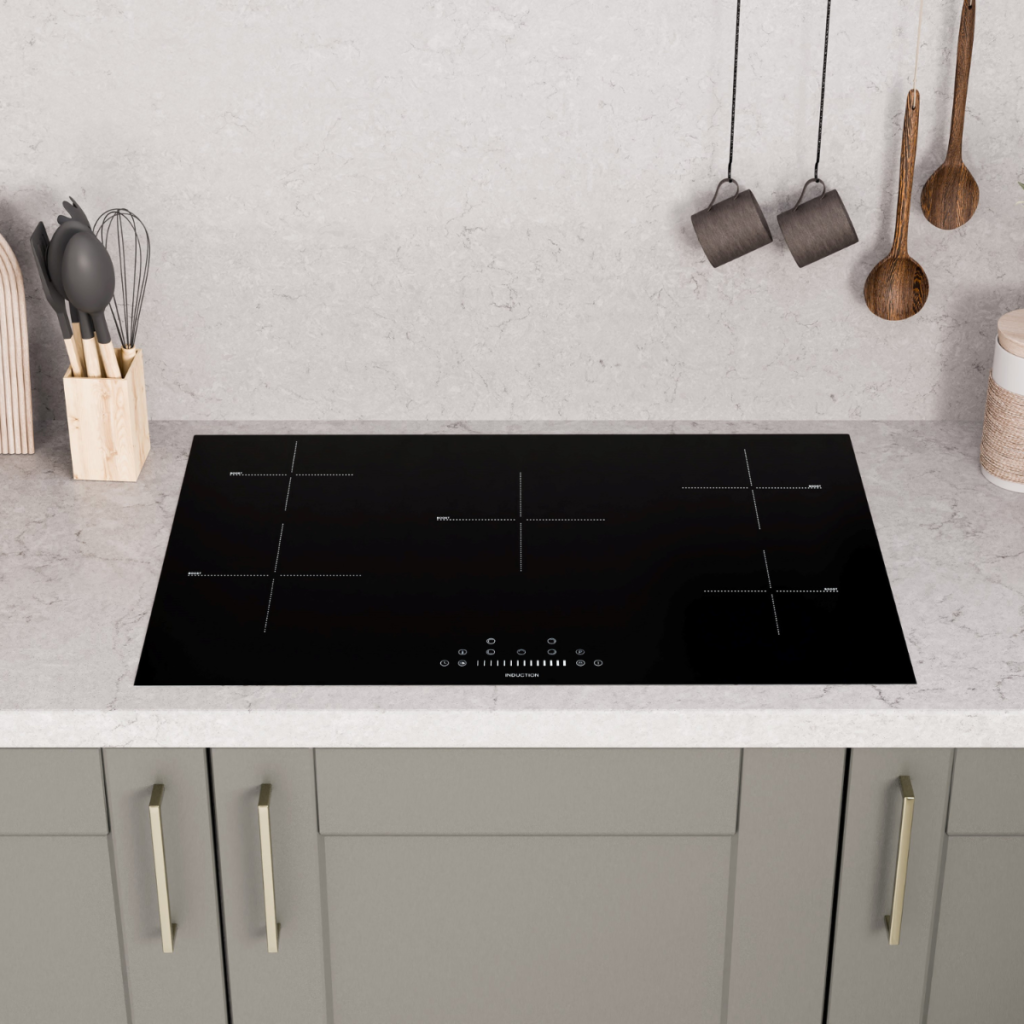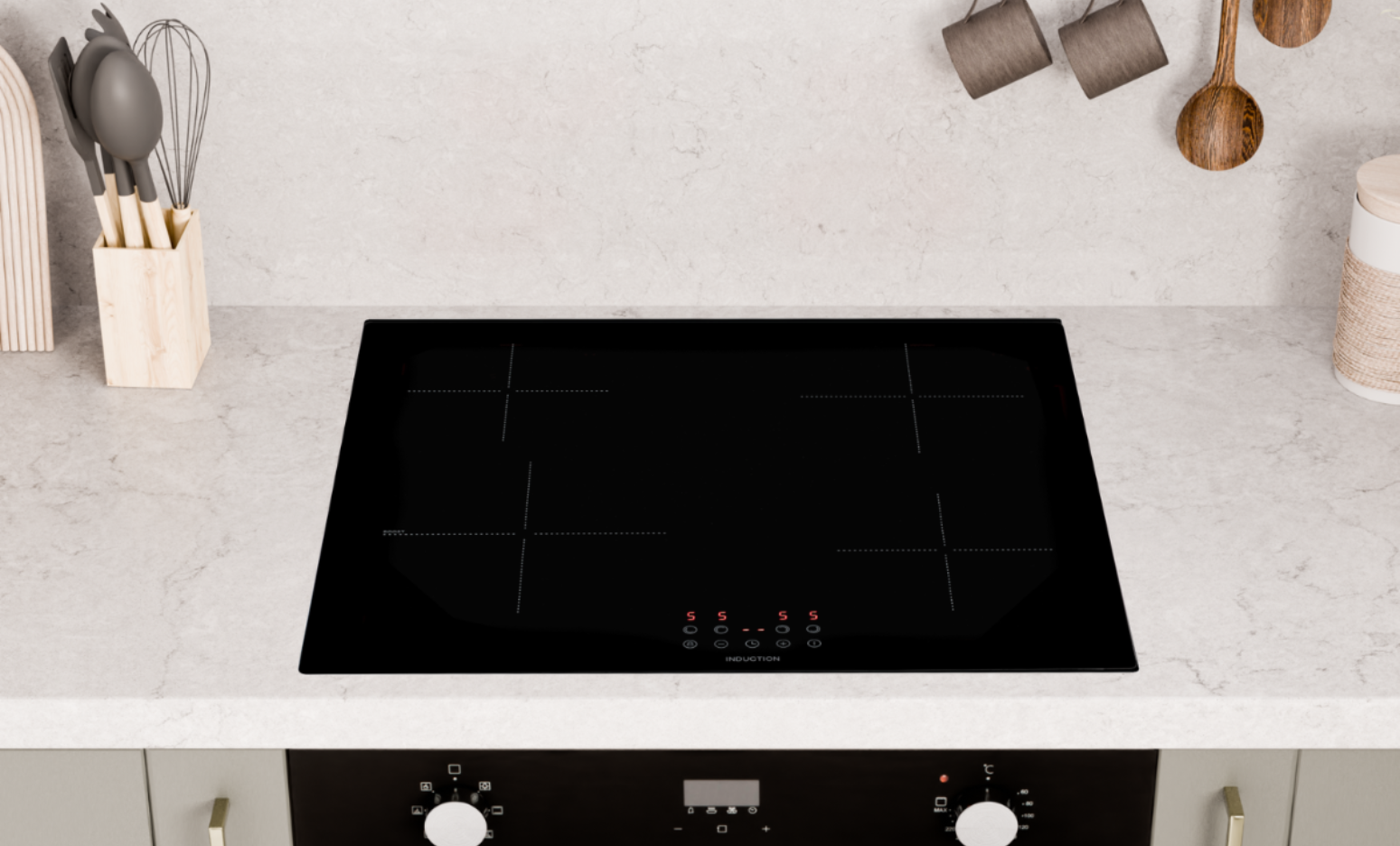What is an induction hob? How do they differ to ceramic hobs?
Hobs are staple appliance in any household kitchen, they're likely to be used every day for boiling, stir frying or simmering. Hobs are a great way to quickly heat food without using too much energy. Some people prefer to buy a cooker, which comes with an oven and a hob in one appliance. Others prefer to purchase each element separately, it all depends on the design of your kitchen, how much space you have and personal preference.
The two most popular types of electric hobs are ceramic and induction.
What is a ceramic hob?
Ceramic hobs refer to the finish of the hob, rather than how they work. They are made of black tempered glass which will sit flush with your countertop and gives a sleek and modern finish that’s often favoured by those who like a minimalist style kitchen. They work by passing electrical currents through coiled elements that are underneath the glass. When the hob is on, the ceramic hob will heat up quickly and will maintain a consistent temperature. Ceramic hobs will either have touch controls or knobs to change the temperature and choose between each cooking zone.
What is an induction hob?
Induction hobs are similar to standard ceramic hobs, however the copper coils underneath the glass surface generate a magnetic field which directly heats the base of the pans. Unlike standard electric hobs, the surface doesn’t get hot which minimises any risk of burns. If you choose this type of hob, then you also have to invest in cookware that is specifically designed for induction hobs. Once an induction-compatible pan has been placed on the switched on cooking zone, the hob will sense the iron content in the base of the pan and begin to heat it. Induction hobs will have touch controls to change the temperature and choose between each cooking zone.
What does an induction hob look like?
Induction hobs are almost identical to ceramic hobs on the outside, they just work differently underneath. They have a smooth glass cooktop and come in a variety of shades, with black being the most popular. The different cooking zones are indicated by circular or coil shaped markings.
How do you know which pans will work on induction hobs?

As induction hobs use electromagnetic heating, the pan must have a magnetic base to work. If you’re unsure if your pan is compatible with an induction hob, then you should look for the induction-compliant symbol. This can usually be found on the bottom of the pan or on the packaging. If you can’t see this symbol, then you can also test it with a magnet. If the magnet sticks to the bottom of the pan, then you know that it’s induction compatible.
How do you install an electric hob?
When installing a new electric hob, there are a number of things to consider:

Do you have a cooker switch? If you don't have a cooker switch, then it's recommended that you look into having one installed as a safety feature. A cooker switch is a means of isolating electrical cookers, hobs or grills. This means that you can turn these appliances on or off whilst keeping other appliances such as fridge freezers or washing machines on. They should be located near the appliances in an accessible location and are designed to handle the amount of electricity needed.
What is the electrical output? The exact measurements that you'll need will depend on the hob's power, however most electric hobs will require a 32-amp circuit. You'll also need to check if the product requires hardwiring or if it has a built in plug.
Is the area safe? You should only install a hob in an area that is clear of any flammable items. For safety reasons, there should be a gap of at least 65cm between either the hob and the ceiling or the hob and the cooker hood if you have one. You should also make sure that the 'hot zone' which comprises of your cooking appliances such as hobs, cookers, ovens etc. is away from your refrigeration appliances.
Do you need an electrician to install your electric hob? It is recommended that a professional electrician installs your hardwired electric hob. Working with electricity can be very dangerous, so it requires someone who knows what they are doing. The UK law requires that a certified electrician carries out and signs off on the installation. If your hob isn't installed by a professional, this could invalidate your product's warranty and your home insurance.
How do you look after a ceramic or induction hob?
As ceramic and induction hobs have a glass surface, you need to make sure you keep them in top condition to ensure they work properly. Whilst the black tempered glass looks stylish and modern, it can easily be scratched.
As explained earlier, there are specific pans for induction hobs but you can use most pans on normal ceramic hobs. It is best to use pans that have an aluminium, stainless steel or titanium base. Try to avoid cast iron cookware – whilst they may look great, they can scratch the surface of the hob over time.
Avoid dragging pans and other cookware over the hob, this can scratch the surface. Whenever you need to move your pans, always make sure that you lift them up properly using any handles. You should also be careful not to drop the pans or any other objects on the glass. Also check that there is no food debris on the bottom of the pan before it is placed onto the cooking zone. Some food debris could scratch the surface of the glass if dragged across the hob.
Don’t put too much pressure or weight on the cooktop. The glass won’t be strong enough to hold a substantial weight, so anything too heavy could weaken it. This could mean that the glass may shatter next time the hob is switched on.

How do you clean a ceramic or induction hob?
One of the benefits of ceramic and induction hobs is that they are really easy to clean. As with all appliances, it’s always recommended to spot clean as you go. If you have a spillage whilst you’re cooking, it’s best to get it cleaned up as soon as possible, before it has a chance to dry down. If you make an effort to clean up after every use, this will prevent any dirt or grease being burnt into the hob surface.
Even if you are spot cleaning after every use, you should still deep clean your hob every month. A good time to do this is when you clean your oven.
How to clean your hob using natural products
Although there are plenty of different types of cleaners on the market, you can avoid using harsh chemicals to clean your hob. All you need to get your hob looking as good as new are the following:
- Baking soda
- Water
- White vinegar
- Microfibre cloth
- Spray bottle
- Paper towels
Ensure that your hob is switched off and the cooking zones are all cool to the touch. If you've been spot cleaning your hob, there should be no spilt food or grime visible. However, if there is, you can wipe it away with a paper towel. Any burnt on bits of food should be soaked off - if you just try to wipe it away it can scratch the glass surface.
If there's no food residue on the hob, you can simply use the white vinegar to remove grease and stains. Fill your spray bottle with the vinegar and apply it to the hob wherever it's needed. Let it sit for a few minutes before gently wiping it away with a damp microfibre cloth.
To remove large areas of grease and stains, create a paste with water and baking soda using a 1:1 ratio. Cover the hob with this paste and leave for at least an hour - longer if you're able to. When you're ready to remove the paste, you can do so with a damp microfibre cloth or a non-abrasive sponge. If you feel like you need to use something more than just water, you can spray the white vinegar onto the paste mixture to create a reaction. The baking soda and the vinegar together will create carbon dioxide bubbles that help to lift the grease and stains.
How do I know which hob is right for me?
If you're still unsure which style of hob is right for you, you can speak to our customer services team. Our phone lines are open between 9am and 5pm, Monday to Friday. You can also drop us an email at support@homefeeling.co.uk and we will get back to you within our opening hours.

